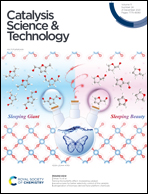DMAP molecule grafting on a carbon nitride heptazine ring for the better degradation of pollutants – the synergy of electron withdrawing and steric hindrance effects†
Abstract
Graphitic carbon nitride (CN) is a promising candidate for use in photocatalytic pollutant degradation, but it only shows moderate activity because of its sluggish photocarrier transfer and insufficient light absorption. Herein, CN@DMAP-X (DMAP is 4-dimethylaminopyridine and X is the amount of DMAP) samples were synthesized using a simple polycondensation strategy via grafting DMAP onto the edge of a g-C3N4 framework. The nucleophilic pyridine ring induces the delocalization of the local electrons of the large number of π-bonds, which alters the electron distribution and avoids in-plane carrier recombination. The steric hindrance effects of the 4-dimethylamino groups on DMAP limit the random growth of the g-C3N4 framework and contribute more layered structures, which can enhance visible light absorption via providing more scattering of light, and this can also provide more accessible active sites for the sunset yellow (SY) macromolecule. CN@DMAP-200 showed optimum visible light degradation efficiency toward SY, up to 2.51 times that of pristine g-C3N4. 1O2 was determined to be the dominant active species for SY degradation, whereas ˙O2− and h+ played secondary roles in photodegradation.



 Please wait while we load your content...
Please wait while we load your content...